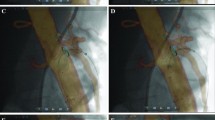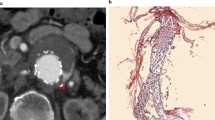Abstract
Purpose
The intent of this report is to describe the technical details and rationale of endovascular septectomy using a wire saw maneuver in cases of chronic aortic dissection and associated infra-renal aortic aneurysm to allow standard endovascular abdominal aortic graft placement; preliminary clinical experience is also retrospectively reviewed.
Materials and Methods
Between June 2013 and June 2016, four consecutive patients (mean age 55.3 years; range 52–58 years) with chronic type B aortic dissection and isolated infra-renal abdominal aortic aneurysm (AAA) underwent endovascular aneurysm repair (EVAR) following guidewire septectomy to create a suitable proximal aortic landing zone. Technical success was evaluated by angiography performed at the end of the procedure. Procedural safety was determined by assessing any major adverse events through 30 days of follow-up. Endoleaks and longer-term efficacy were evaluated.
Results
Four patients with chronic aortic dissections had associated AAA with a mean maximum diameter of 60 ± 13 mm (range 50–77 mm). All underwent guidewire saw septectomy to facilitate EVAR. Following successful septectomy, standard abdominal bifurcated endografts were implanted uneventfully. No major adverse events and no endoleaks were noted on CT angiographic examinations through 30 days following the procedure. Also, no rupture, re-intervention or endoleak has been noted during follow-up at a mean of 21.8 ± 15 months (range 4–39 months).
Conclusions
Guidewire saw septectomy is a technique that has the potential to create an anatomically suitable proximal neck for successful EVAR management of AAA in select patients with associated chronic aortic dissection.



Similar content being viewed by others
References
Williams DM, Brothers TE, Messina LM. Relief of mesenteric ischemia in type III aortic dissection with percutaneous fenestration of the aortic septum. Radiology. 1990;174:450–2.
Hartnell GG, Gates J. Aortic fenestration: a why, when, and how-to guide. Radiographics. 2005;25:175–89.
Wuest W, Goltz J, Ritter C, Yildirim C, Hahn D, Kickuth R. Fenestration of aortic dissection using a fluoroscopy-based needle re-entry catheter system. Cardiovasc Interv Radiol. 2011;34:S44–7.
Tashiro J, Baqai A, Goldstein LJ, Salsamendi JT, Taubman M, Rey J. “Cheese wire” fenestration of a chronic aortic dissection flap for endovascular repair of a contained aneurysm rupture. J Vasc Surg. 2014;60:497–9.
Ullery BW, Chandra V, Dake M, Lee JT. Cheese wire fenestration of a chronic juxtarenal dissection flap to facilitate proximal neck fixation during EVAR. Ann Vasc Surg. 2015;29:124.e1–5.
Kos S, Gürke L, Jacob AL. A novel fenestration technique for abdominal aortic dissection membranes using a combination of a needle re-entry catheter and the “cheese-wire” technique. Cardiovasc Interv Radiol. 2011;34:1296–302.
Watkinson AF. A novel “cheese wire” technique for stent positioning following difficult iliac artery subintimal dissection and aortic re-entry. Cardiovasc Interv Radiol. 2009;32:781–4.
Brunori A, Bruni P, Greco R, Giuffré R, Chiappetta F. Celebrating the centennial (1894–1994): Leonardo Gigli and his wire saw. J Neurosurg. 1995;82:1086–90.
Author information
Authors and Affiliations
Corresponding author
Ethics declarations
Disclosure Statement
Venita Chandra reports non-financial support from Cook Medical, non-financial support from W. L. Gore and personal fees from Trivascular, outside the submitted work. Michel D. Dake reports grants and personal fees from Cook Medical, grants and personal fees from W. L. Gore, and personal fees from Trivascular, outside the submitted work. All other authors declare that they have no conflict of interest.
Rights and permissions
About this article
Cite this article
Gissler, M.C., Ogawa, Y., Lee, J.T. et al. Percutaneous Septectomy in Chronic Dissection with Abdominal Aortic Aneurysm Creates Uniluminal Neck for EVAR. Cardiovasc Intervent Radiol 40, 1522–1528 (2017). https://doi.org/10.1007/s00270-017-1668-3
Received:
Accepted:
Published:
Issue Date:
DOI: https://doi.org/10.1007/s00270-017-1668-3




